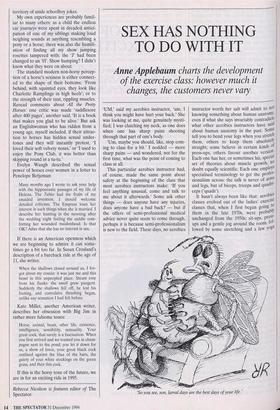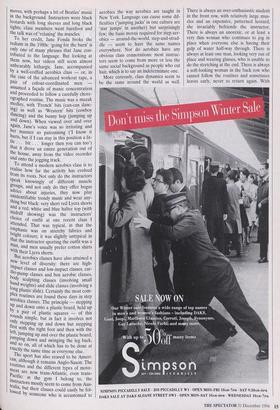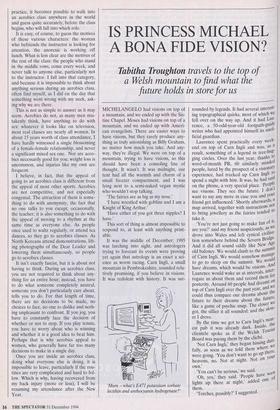SEX HAS NOTHING TO DO WITH IT
Anne Applebaum charts the development
of the exercise class: however much it changes, the customers never vary
'UM,' said my aerobics instructor, `um, I think you might have hurt your back.' She was looking at me, quite genuinely mysti- fied; I was clutching my neck, as one does when one has sharp pains shooting through that part of one's body.
'Urn, maybe you should, like, stop com- ing to class for a bit.' I nodded — more sharp pains — and wondered, not for the first time, what was the point of coming to class at all.
This particular aerobics instructor had, of course, made the same point about safety at the beginning of the class that most aerobics instructors make: 'If you feel anything unusual, come and talk to me about it afterwards.' Some ask other things — does anyone have any injuries, does anyone have a bad back? — but if the offers of semi-professional medical advice never quite seem to come through, perhaps it is because semi-professionalism is new to the field. These days, no aerobics instructor worth her salt will admit to not knowing something about human anatoraY, even if what she says invariably contradicts what other aerobics instructors have said about human anatomy in the past. Some tell you to bend your legs when you stretch them, others to keep them absolutely straight; some believe in certain kinds of press-ups, others favour another version. Each one has her, or sometimes his, special set of theories about muscle growth, n° doubt equally scientific. Each one cmploYs specialised terminology to get the profes- sionalism across: the talk is never of arms and legs, but of biceps, triceps and quadri- ceps ('quads'). It hasn't always been like that: aerobics classes evolved out of the ladies' exercise classes that, when I first began going t° them in the late 1970s, were probably unchanged from the 1950s: sit-ups, press- ups and a gentle jog around the room, fol- lowed by some stretching and a few yoga 'So you see, son, larval days are the best days of your life.' moves, with perhaps a bit of Beatles' music in the background. Instructors wore black leotards with long sleeves and long black tights; class members went barefoot and the talk was of 'relaxing' the muscles.
To her credit, Jane Fonda broke the tedium in the 1980s: 'going for the burn' is only one of many phrases that Jane con- tributed to the language. But looking at them now., her videos still seem almost unbearably lethargic. Jane, accompanied by a well-coiffed aerobics class — or, in the case of the advanced workout tape, a pair of colour-coordinated men — assumed a façade of manic concentration and proceeded to follow a carefully chore- ographed routine. The music was a muzak medley, with 'French' bits (can-can danc- ing) as well as 'Western' bits (cowboy dancing) and the bunny hop (jumping up and down). When viewed over and over again, Jane's voice was so irritating and her manner so patronising CI know it hurts, but if I can stay in this position a lit- tle • • . bit . . . longer then you can too') that it drove an entire generation out of the house, away from the video recorder and onto the jogging track. To attend a modern aerobics class is to realise how far the activity has evolved from its roots. Not only do the instructors speak knowingly of different muscle groups, and not only do they offer bogus advice about injuries, they now play unidentifiable trendy music and wear any- thing but black: very short red Lycra shorts and a red, white and blue halter top (with midriff showing) was the instructors' choice of outfit at one recent class I attended. That was typical, in that the emphasis was on stretchy fabrics and bright colours; it was slightly untypical in that the instructor sporting the outfit was a man, and men usually prefer cotton shirts With their Lycra shorts. But aerobics classes have also attained a 11. ew level of diversity: there are high- impact classes and low-impact classes, car- dio-pump- classes and box aerobic classes, body sculpting classes (involving small hand weights) and slide classes (involving a long plastic slide). Certainly the most com- Plex routines are found these days in step aerobics classes. The principle — stepping UP and down onto a plastic board, held up by a pair of plastic squares — of this sounds simple, but in fact it involves not Only stepping up and down but stepping first with the right foot and then with the left, jumping up and over the plastic board, Jumping down and swinging the leg back, and so on, all of which has to be done at exactly the same time as everyone else. The sport has also ceased to be Ameri- can, although it remains Anglo-Saxon. The routines and the different types of move- ment are now trans-Atlantic, even trans- pacific: at the gym I belong to, the instructors mostly seem to come from Aus- tralia, but their classes could easily be fol- lowed by someone who is accustomed to
aerobics the way aerobics are taught in New York. Language can cause some dif- ficulties (lumping jacks' in one culture are `star jumps' in another) but surprisingly few; the basic moves required for step aer- obics — around-the-world, step-and-strad- dle — seem to have the same names everywhere. Nor do aerobics have any obvious class connotations: most instruc- tors seem to come from more or less the same social background as people who cut hair, which is to say an indeterminate one. More curiously, class dynamics seem to be the same around the world as well. There is always an over-enthusiastic student in the front row, with relatively large mus- cles and an expensive, patterned leotard; she invariably befriends the instructor. There is always an anorexic, or at least a very thin woman who continues to jog in place when everyone else is having their gulp of water half-way through. There is always at least one man, looking very out of place and wearing glasses, who is unable to do the stretching at the end. There is always a soft-looking woman in the back row who cannot follow the routines and sometimes leaves early, never to return again. With practice, it becomes possible to walk into an aerobics class anywhere in the world and guess quite accurately, before the class begins, who will fall into which role.
It is easy, of course, to guess the motives of these various characters: the woman who befriends the instructor is looking for attention, the anorexic is working off lunch. What is less clear are the motives of the rest of the class: the people who stand in the middle rows, come every week, and never talk to anyone else, particularly not to the instructor. I fall into that category, and because it is impossible to think about anything serious during an aerobics class, often find myself, as I did on the day that something went wrong with my neck, ask- ing why we are there.
This is not as simple to answer as it may seem. Aerobics do not, as many men mis- takenly think, have anything to do with sex: whatever it looks like on television, most real classes are nearly all women. In about 15 years worth of class attendance, I have hardly witnessed a single blossoming of a female-female relationship, and never a significant mixed sex one. Nor are aero- bics necessarily good for you; weight loss is uncommon, and injuries like my own are frequent.
I believe, in fact, that the appeal of going to an aerobics class is different from the appeal of most other sports. Aerobics are not competitive, and not especially congenial. The attraction of them is some- thing to do with anonymity, the fact that no one talks to you except, occasionally, the teacher; it is also something to do with the appeal of moving to a rhythm at the same time as everyone else. As people once used to waltz regularly, or attend tea dances, so they go to aerobics classes. As North Koreans attend demonstrations, lift- ing photographs of the Dear Leader and lowering them simultaneously, so people go to aerobics classes.
It isn't exactly fascist, but it is about not having to think. During an aerobics class, you are not required to think about any- thing for an entire hour; instead, you have to do what someone completely neutral, someone you don't particularly care about, tells you to do. For that length of time, there are no decisions to be made, no choices to face, no one to dislike and noth- ing unpleasant to confront. If you jog, you have to constantly face the decision of whether or not to stop. If you play tennis, you have to worry about who is winning and whether it is a good idea to beat him. Perhaps that is why aerobics appeal to women, who generally have far too many decisions to make in a single day.
Once you are inside an aerobics class, doing what everyone else is doing, it is impossible to leave, particularly if the rou- tines are very complicated and hard to fol- low. Which is why, having recovered from my back injury (more or less), I will be resuming my attendance after the New Year.




























































 Previous page
Previous page